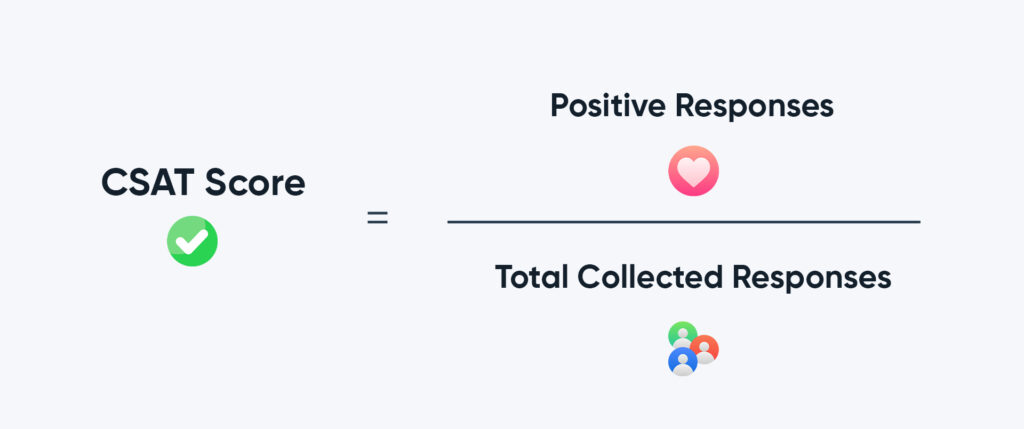You already know that call centers exist either to support current customers or to generate new ones—most of the time, it’s a healthy combination of the two. So, we are here to tell you about an invaluable way to manage these two goals: CSAT measurement and improvement.
Whether you are looking to strengthen the loyalties of your existing customers or to convert potential consumers, your main aim is to satisfy every person you interact with in order to keep them coming back. The importance of customer satisfaction is undeniable.
That is why you need to know about CSAT measurement and improvement in your call center. Understanding CSAT scores and learning how to measure customer satisfaction can save time and money by letting you know what your callers are thinking and expecting.
What is the Customer Satisfaction Score (CSAT)?
CSAT stands for Customer Satisfaction Score. Depending on how you conduct the research and analyze the outcomes, you can think of it as both a qualitative and a quantitative research method to see how satisfied your customers are with your business, services, and products.
The longer the answers to your questions, the more qualitative information you will receive. And the qualitative feedback you gain is a great way to learn more about customer expectations. However, callers often want the survey to be as quick and convenient as possible, so quantitative questions that require binary and numerical answers are often preferred.
CSAT vs. NPS—What’s the Difference?
CSAT and NPS are both customer satisfaction metrics. The only difference between CSAT and NPS is that while CSAT measures overall customer satisfaction, NPS only measures customer loyalty, which you may consider a part of customer satisfaction since only satisfied customers would be loyal to a brand.
Basically, an NPS survey would ask the customer, “How likely are you to recommend our brand to others?” Even though the wording may differ, the NPS question always asks one basic question: Would you promote us? This question is often answered on a scale and can be a part of a CSAT survey.
However, there are a few more metrics to measure customer satisfaction in your call center.
What Types of Metrics Measure Customer Satisfaction?
CSAT and NPS being the most common ways to measure customer satisfaction in a call center, there are 5 more ways to measure customer satisfaction.
Customer Service Satisfaction (CSS)
A CSS score indicates how satisfied a customer is with your post-purchase service.
Customer Effort Score (CES)
A CES score indicates how easy, or hard, a customer finds getting an issue resolved, a request fulfilled, a product purchased/returned, or a question answered.
Customer Health Score (CHS)
A CHS score indicates how much of a healthy relationship a customer has with a brand, considering many aspects such as overall product usage, account growth, and the number of renewals.
Customer Churn Rate (CCR)
The CCR indicates the percentage of customers that have been lost within a specific period of time.
Customer Reviews
Customer reviews reflect a customer’s experience with your brand, products, or services. Unlike other CX metrics, customers can leave reviews about your brand across multiple channels.

An important note here is that you must decide what you want to measure before deciding how you will.
For instance, if you’re trying to measure customer service quality and how well your call center is interacting with customers, CSAT and NPS evaluations will be the way to go.
However, if you’re looking for a metric that measures customer satisfaction with your provided product/service, it would be best that you conduct CSS or CHS via your call center instead.
Once you’ve decided on how to measure customer satisfaction, all left is to create an automated survey! Then, you can conduct them right at the end of the call or schedule call-backs for later on!
How to Measure Your CSAT?
Measuring customer satisfaction scores entails asking a set of questions—predetermined by your business—directly to your customers to gain customer satisfaction feedback and calculate the value in a standardized fashion.
How to measure customer satisfaction often depends on the unique set of CSAT metrics at a business. Therefore, there is no definitive way to measure CSAT, but a survey with a rating system is the most common format. There are also various forms of rating systems and questions.
You can present questions with:
- binary systems (yes/no),
- scales (1-10),
- short multiple-choice options (e.g., not satisfied, somewhat satisfied, and very satisfied),
- statements and see how much the customer agrees with them (a.k.a. Likert Scale)
- open-text answers for which customers can make comments with their own words.
Some typical questions are:
- “Are you satisfied with…?” (Yes or No)
- “How satisfied are you with…?” (Numerical Scale)
- “Which product feature do you use most often?” (Multiple-Choice List of Features)
- “The website was easy to navigate” (Agree/Disagree, a Numerical Scale, or even emojis!)
- “How can we improve your experience with the company?” (Open-Text)
Need more questions to ask in a customer satisfaction survey? Read through to discover our customer service questionnaire examples.
Are you looking for a customer satisfaction measurement tool that won’t take up your agents’ time? Discover how you can create automated satisfaction-survey calls with Call Center Studio!
How to Calculate CSAT Score
Are you trying to figure out how to calculate CSAT? While there is no clear-cut way to get your customer satisfaction feedback, there is a simple customer satisfaction score calculation that you can use once you’ve determined your question set and rating system.
To measure the CSAT score after collecting the data, you have to add up all positive responses and divide them by the number of total collected responses and multiply by 100. As a result, you will get a percentage that will provide a clear idea of your customer satisfaction rate and call center performance.

Make Sense of Your CSAT Score—Is It Good or Bad?
Many factors play into determining if your CSAT score is good enough. The scores are usually based on the types of questions you ask and how you ask them. If you ask for quarterly customer satisfaction feedback, the score will be stable until the next rating. However, if you ask your callers to rate the agents after each call, the score will constantly change, in which case you will have to be more vigilant.
The adequacy of the score depends on the industry average and the metrics used. You may want to focus on increasing your ratings and forgo comparing your ratings to others in the same industry since your standards might differ.
All things considered, the importance of customer satisfaction remains the same. A helpful rule of thumb would be to keep your CSAT score above 75% so that 3 out of 4 customers are satisfied.
CSAT Question Examples
Wondering what to ask in your CSAT questionnaire? Here are a few options for you to consider to measure customer service of your call center.
- Did you receive the outcome you needed from the interaction? (Yes/No)
- Were you able to resolve your query on your first call? (Yes/No)
- Was the service you received timely and efficient? (Yes/No)
- On a scale of 1-10, how likely are you to recommend our services to others?
- On a scale of 1-5, how would you rate the friendliness of your agent?
- On a scale of 1-10, how satisfied are you with your hold time?
- How satisfied are you with our services? (Satisfied, Somewhat Satisfied, Very Satisfied)
- How would you rate our IVR for ease of use? (Very Easy, Somewhat Easy, Complicated)
- How would you rate the friendliness of your representative? (Poor, Mediocre, Excellent)
- The voicebot option was clear and efficient. (Likert Scale)
- The customer service agent was knowledgeable. (Likert Scale)
- I am satisfied with the service I received. (Likert Scale)
- How can we make our customer service more satisfactory? (Open-Text)
Keep in mind that for non-binary rating systems, you will have to determine what response determines a satisfied customer. On a scale of 1-10, will 6 be considered a positive response?

CSAT Tools
You have all the questions ready but don’t know how to start calculating CSAT? While there are many tools for measuring customer satisfaction, it’s important that you opt for the one that will not be a hassle to manage.
Here are some of the most effective CSAT solutions to conduct customer surveys.
End-of-call surveys
Many call centers ask callers if they would like to evaluate the call at the end of the conversation. If the caller answers, or dials “Yes,” they transfer the call to an IVR system that asks the predefined question set.
Call-back surveys
Another common way to collect customer responses is by conducting automated call-backs. With today’s call center technologies, all you have to do is script your questionnaire, determine a call-back period and deploy a dialer that will automatically call back customers for feedback.
Chat surveys
Today, almost all call center operations are multichannel. If that’s the case for you, you can utilize your chat channels—WhatsApp, webchat, and many more—to send CSAT survey links to your customers.
Chat channels are perfect to utilize as customer satisfaction measurement tools. Discover Call Center Studio’s Multichannel options to get a deeper insight into your CSAT score!
10 Quick Tips to Improve Your CSAT Score
Are your CSAT scores not what you expected? Do not worry at all—here are some quick and easy tips on how to improve CSAT scores in a call center.
1. Learn Customer Expectations
Ironically, the first step in improving your customer satisfaction score is to measure it. This step is beneficial not only because you will discover where you stand with the customers but because you will learn about their expectations.
If you tailor your questions correctly, even a quantitative question can have a qualitative answer. Make sure that you are asking the right questions by inquiring about specific attributes and features. Provide clear instructions so that the caller knows exactly what they are grading. Finally, there is a fine line between wanting to learn more about customer expectations and overwhelming the customer with questions, so tread carefully.
Need more insight into what your customers need? Call Center Studio’s monitoring tools give you both real-time and historical access to calls and help you filter them by keywords!
2. Improve Your Tech
There are multiple benefits to improving the technologies you use and provide to your customers. For instance, offering your customers help via a multichannel communication network lets them choose whichever platform they feel most comfortable with to contact you.
In today’s world, customers want autonomy. Call center technologies—like AI-powered voicebots and chatbots, multi-channel solutions, and CRM integrations—help agents handle more clients in less time. Plus, they empower customers to take the reins of their own customer journey. This brings us to our next point.
3. Experience the Journey
To improve CSAT score, you have to have a grasp of what you offer to your customers. And, there really is no better way to judge the journey you’ve built for your customers than to live through it yourself.
Call your own call center for different queries and see what happens. Does the IVR have adequate options? Is the voicebot clear? How long do you wait to get a response? Is your call routed to the correct agent? How knowledgeable and friendly is the agent?
After you’ve gone through various customer journey paths, turn your observations into constructive feedback and make an action plan accordingly. Should you update the IVR? Do your agents need more training? Should you change your software to provide more comprehensive customer service?
4. Train Your Agents
Call center owners should ensure regular training programs for their agents. Offering development programs and courses will allow agents to learn new things which they will apply while engaging with consumers. It will help improve the response rate and time. Moreover, benefit the organization. Agents will have more grip over the latest technology and devices, making it easier for them to adapt. Therefore, training can bring a tremendous positive change to the company.
5. No, Really Train Them
Don’t just train your agents to handle and manage callers. Empower them to truly listen to what the customers need. Their position is a key one in the customer journey leading up to, during, and after a purchase is made. If they treat your customers right, any survey will undoubtedly reflect customer satisfaction.
Also, share with them the main pain points customers face with your business and within the industry in general so that the agents may be prepared for any incoming issue or inquiry. A good understanding of the brand and customer expectations will allow agents to handle them more effectively and ensure they leave great feedback on the CSAT questionnaire.
The foremost step in training your agents is training your team leaders!
Download our free ebook to create the best of them!
6. Listen to Your Agents
Now that your agents are trained, you need to trust their insight.
Your agents are the people who are in the most direct form of contact with your customers and callers. They are the ones to hear the customer grunt or sigh at specific moments during a call. So, they have an unrivaled insight into your customer’s experiences. You must hear them out when they tell you what is working and what is not at your call center.
Showing your agents you trust them enough to take action according to their ideas will also empower them to take the initiative to solve customer problems more efficiently.
7. Review Reviews
Most CSAT surveys need to actively prompt customers for a response. Thus, the responses are usually forced. On the other hand, customers leave online reviews and comments when they strongly feel they need to give their opinions about an experience.
Nearly every online platform has become a review site. Do not miss out on what customers and callers are saying about the customer service at your brand. By reading online reviews, you will be able to hear the honest—and often unfiltered— opinions of your customers. This way, you may find the weaknesses and strengths that people have experienced in the customer journey you have built for them so you can improve on it.
8. Customize for your customers
In this day and age, most businesses make sure that they convey the importance of each customer by personalizing the customer experience. People feel special when the brand they interact with emphasizes how valuable they are to the business.
Remembering the very basic information about your callers will not only strengthen your relationship with them but might also brighten up their day and encourage them to give some positive feedback.
9. Reduce Wait Time
A common complaint that most customers have is having to wait for a long time to get an answer from a representative. They are left on hold for minutes, or sometimes no one even picks up their call. This situation lowers call center customer satisfaction rates and leaves your agents vulnerable to angry callers.
Therefore, it is essential to minimize the wait time to only a few seconds. It will significantly improve customer satisfaction because they will feel heard and understood. Moreover, it will increase consumer loyalty in the long run.
There are a lot of KPIs that can affect your overall CSAT score! Check out these important call center metrics that you have to keep track of!
10. Pay Attention to the Passives
When measuring a customer satisfaction score, “passives” are the feedback that are halfway between good and bad. If you were to ask, “On a scale of 1-10, how satisfied are you with our services?” the passives would be a 5 or a 6.
If you’re tired of receiving these passive scores, here’s a tip that can come in handy—use a rating scale out of 4 or 6 so that the options are more polarized, which, in turn, requires more mindful responses from the customers.
Most people tend to ignore the average outcome, especially when it comes to feedback. The average is often expected and less exciting than good or bad reviews. However, always keep in mind that every score comes from a human being, and the ones who give average feedback are often on the fence. Think about what you can do to help them come off the fence.
To Wrap It Up
Calculating your CSAT score is a smart and practical step you need to take for your business, especially in an era where customers have lots to pick from. We hope that these 10 tips will help you get started to improve your customer satisfaction!
Need more help? Talk to our experts to discuss your operational needs, or better yet, book a demo today to see how Call Center Studio can help you improve your CSAT and set you on your way to success.




